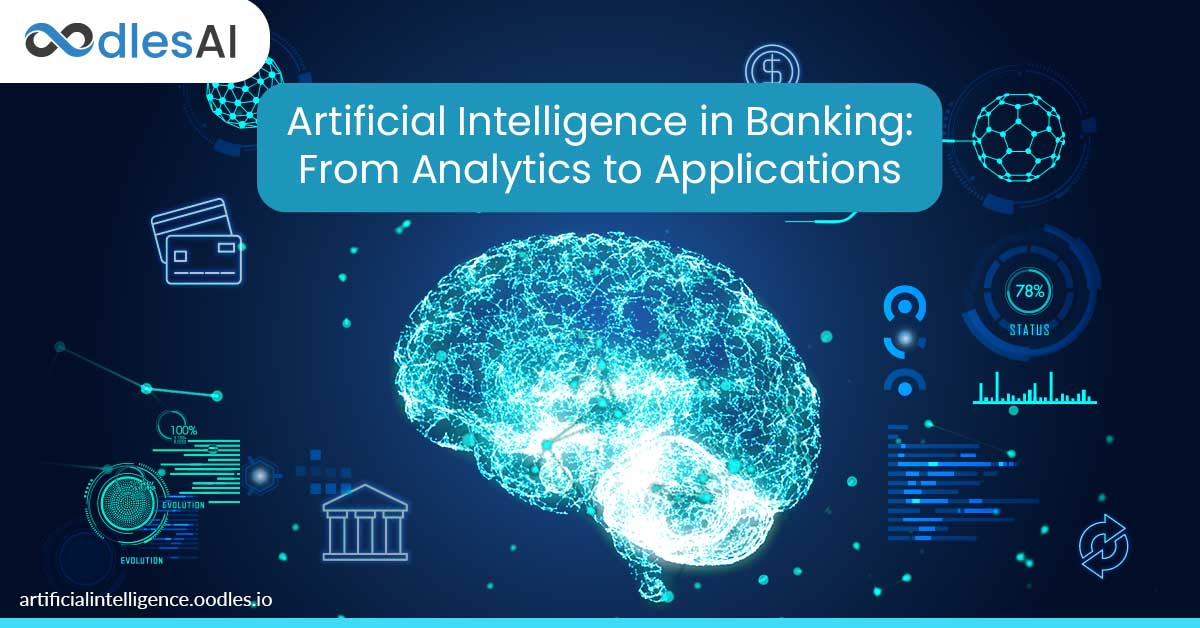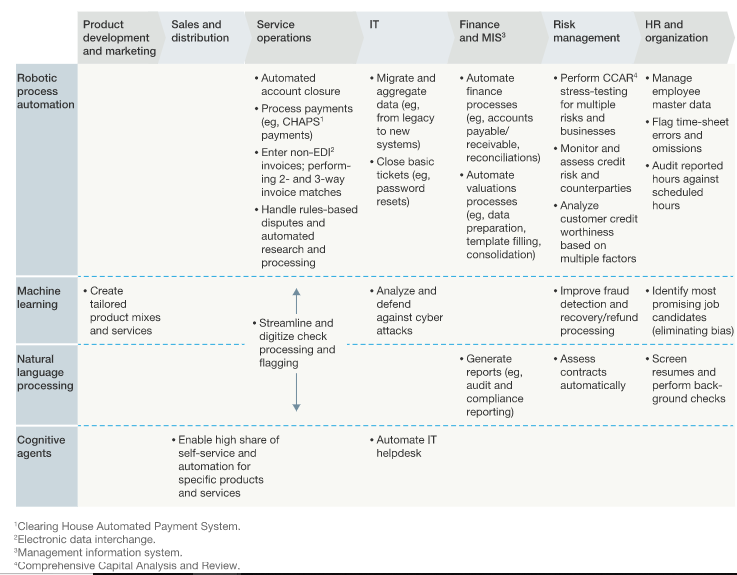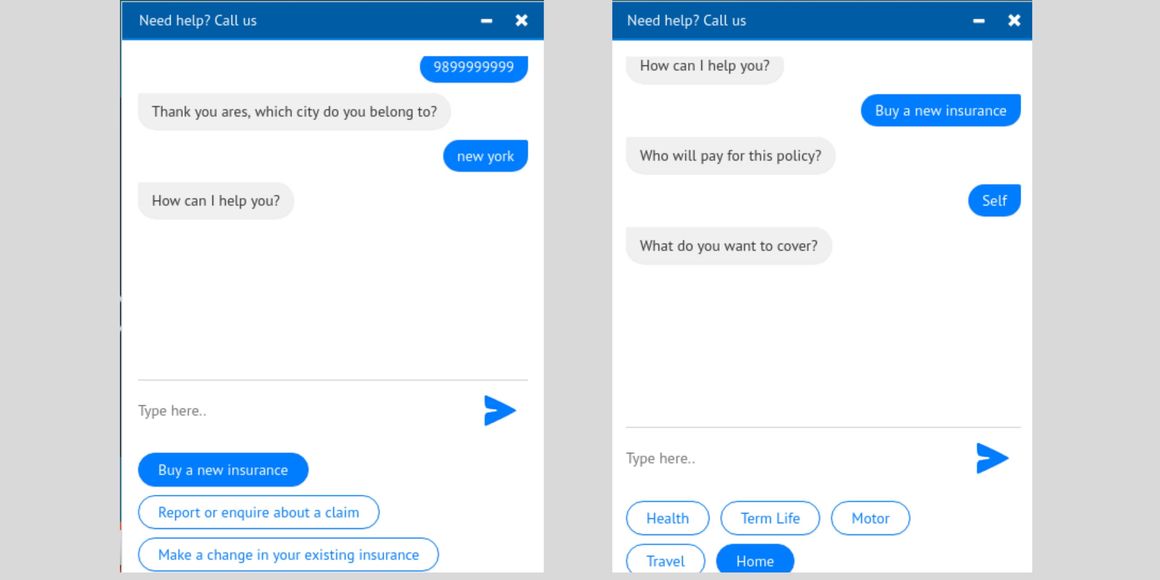Artificial Intelligence in Banking: From Analytics to Applications
Sanam Malhotra | 6th July 2020

Amid unprecedented global crises, artificial intelligence (AI) is enabling banks to bridge the chasm between technology and services. To rebound in the new normal with rapid digital transformation, banks are largely betting on dynamic artificial intelligence services. Powered by machine learning, artificial intelligence in banking promises adaptive applications, in-depth analytics, efficient automation, and enhanced customer services.
We, at Oodles, maps the implications of COVID-19 for the banking industry along with future-proof AI applications to ensure resilience and optimization.
#COVID: Implications for the Banking Industry
The banking industry is currently facing the COVID-19 fallout causing profound stress and unpredictability in the global macro-economic environment. From workforce disruptions and digital immaturity to reduced customer confidence and consumption, banks are striving for resilience and adaptability.
The financial services industry is facing economic implications at a level reminiscent of the worst crisis in the last 100 years, suggested Mckinsey Global Institute.
While the COVID-led crises continue to splay across the industry’s value chain, below are the major banking issues demanding immediate actions-
a) Credit management to curb non-performing loans
b) Adoption of technology-led operations and channels
c) Provision of contactless and digital customer services, and
d) Adapt to digitization across branch operations.
With a major focus on embracing advanced technologies, we, at Oodles, explore how artificial intelligence in banking can future-proof ecosystems significantly.
#PostCOVID: Future-ready Banking Automation With Artificial Intelligence
While automation is not a nascent initiative for banks, the future demands more intense use of advanced analytics and AI-powered applications. In an effort to combat COVID-crisis with heightened productivity, cost savings, and improvement in customer services, banks must embrace AI and machine learning.
With the ability to analyze prodigious amounts of data, artificial intelligence models are giving rise to more specialized and personalized banking solutions.

McKinsey Global Institute maps a wide range of AI-driven banking applications powered by machine learning, NLP, and RPA to drive efficiency and better outcomes.
At Oodles, our AI development team is channelizing its expertise in AI, machine learning, NLP, and deep learning to build specialized banking solutions. We build and deploy function-specific AI applications that streamline the entire baning value chain from marketing to sales and risk management.
Let’s explore some of these data-driven solutions for fueling the revival of banks in the post-COVID world.
Artificial Intelligence in Banking: Adaptive Applications for Post COVID Revival
1) AI-powered OCR for Contactless Customer Onboarding
Though banking operations are up and running in a majority of lockdown-stricken countries, customer services were hampered drastically due to precautionary norms. To ensure seamless onboarding of customers through digital channels, AI-infused Optical Character Recognition (OCR) is gaining momentum among banks of the future.
Contrary to traditional OCR systems, machine learning-based OCR enables banks to extract text from structured and unstructured documents with near-perfect accuracy.
By boosting speed, efficiency, and efficacy, AI-led OCR scanning services can be deployed for several banking operations under remote conditions, such as-
a) eKYC for onboarding customer through digital channels
b) Digitization of financial reports and invoices
c) Digitization of checks, debit and credit card details
d) Data extraction from application forms and banking statements.

Recently, Oodles’ AI team built an AI-OCR model for automating text extraction from identity cards including Aadhar cards, passport, DL, and more. The system works on TensorFlow and OpenCV to identify and classify text from complex documents for lowering operational costs and optimizing digital onboarding processes.
Also read- AI-OCR for Invoice Processing: Automating Accounts and Payments
2) Customer Analytics and Personalized Engagement
Data is the most important cornerstone of artificial intelligence in banking. Banks channelizing unutilized customer data toward expansive insight generation are projected to be the big winners of the post-COVID world.
With algorithmic advancements, today AI is able to process customer, market, and research-based data to extract valuable insights, including-
a) Evaluation of customer spendings to provide tailored offers
b) Understanding customer demographics to initiate targeted campaigns
c) Analysis of customers’ buying history to suggest customized products and discounts
d) Addressing customer needs remotely via virtual agents and chatbots
e) Monitoring of credit-card statements to predict future defaulters, and more.

To handle customer queries and needs 24*7 for an insurance provider, Oodles’ AI team built an intelligent website chatbot that engages customers with product information. In addition, such chatbots are increasingly impacting business upselling efforts by facilitating built-in lead generation forms and personalized offers.
Also read- The Compelling Case of AI and Machine Learning (ML) in Insurance
3) Facial Recognition for Mobile Authentication
Banking setups are fast replacing legacy OTP and PIN-based authentication with biometric and facial recognition-based authentication. To ensure mobile security in the times of swelling cybercrime cases, banks must adopt AI-powered facial recognition technology.
Commonly used to authenticate transactions, SMS-based OTPs are turning an inconvenient, insecure, and highly vulnerable security check.
Under artificial intelligence in banking, deep learning techniques can identify customers based on unique nodal features to eliminate fraud and anomalies. AI-based facial recognition can not only provide integration across computer systems but also for seamless mobile banking experience.

Originally built for automating employee attendance, the facial recognition system developed by Oodles’ AI team can be further used for identity verification purposes. With over 90% accuracy achieved, our AI team is constantly exploring new ways of creating value for the banking industry with AI-led automation.
Connect with our AI development team to uncover more such result-driven applications of artificial intelligence in the banking and insurance sectors.



